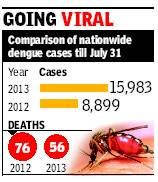Dengue: India

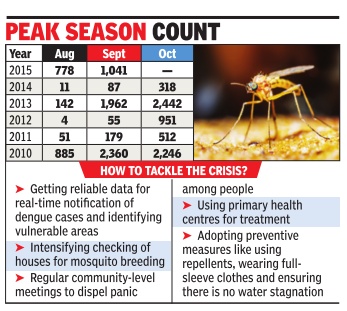
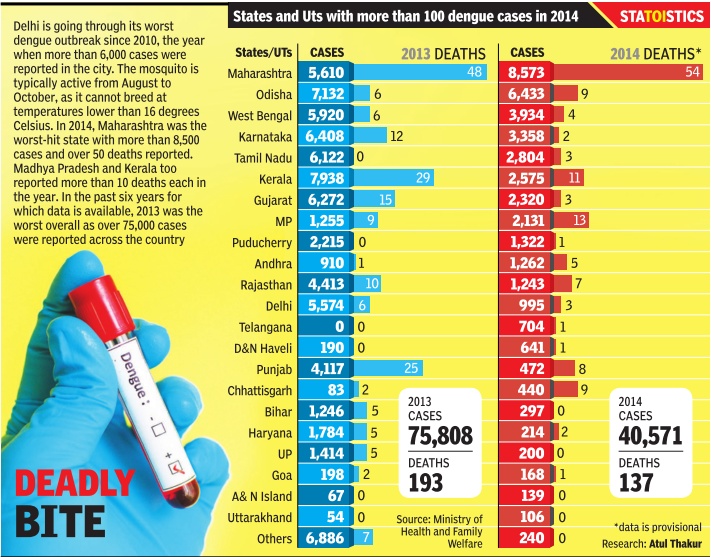
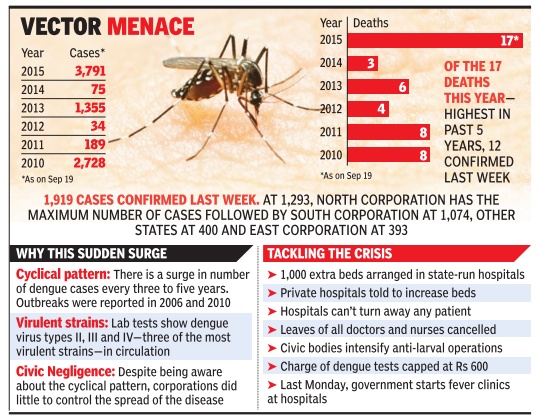
This is a collection of articles archived for the excellence of their content. |
Contents |
2013
Alarming 80% rise in dengue cases in 2013
Durgesh Nandan Jha TNN
The Times of India 2013/08/21
New Delhi: Dengue cases have risen alarmingly across the country this year, with data showing an 80% rise in the disease till July 31 as compared to the same period last year.
India has recorded 15,983 dengue cases so far in 2013 as compared to 8,899 cases in the corresponding months last year, latest health ministry data shows. But the good news is, while the cases have risen sharply, fatalities have actually declined — 56 as compared to 76 last year.
Kerala reported most dengue cases at 5,801, followed by Karnataka (3,775), Tamil Nadu (3079) and Maharashtra (961) till end-July. Delhi witnessed a sharp rise in cases over the last few weeks, with the total this year touching 54. No one has died due to dengue in the capital so far.
‘Several factors for spread of dengue’
“There is no single reason for the increase in dengue cases. It is governed by various man-made and environmental factors including unprecedented growth in population, unplanned and rapid urbanization and inadequate waste management,” union health minister Ghulam Nabi Azad stated in a written reply in the Lok Sabha on Tuesday.
Increasing mobility of the population and poor infrastructure to monitor mosquito breeding were some other reasons cited by the health minister. Azad said guidelines for clinical management of dengue cases have been sent to the states for circulation in hospitals and rapid response teams have been formed.
Dengue, termed by many experts as the world’s most rapidly spreading mosquito-borne viral disease, is caused by four serotypes. While type I and III are milder in nature causing classic dengue fever and fever without shock, respectively, dengue type II and IV are considered deadly. These cause fever, bleeding and a drop in platelet count. Researchers say severe dengue cases, dengue hemorrhagic fever and dengue shock syndrome, started showing up in India since 1988.
“A reason behind the increased frequency could be the presence of many strains of the virus. It exposes people already infected to become susceptible to infection as they are not immune to all the subtypes,” said Dr Ekta Gupta, clinical virologist at the Institute of Liver and Biliary Sciences (ILBS).
Experts say construction sites are a major area of mosquito-breeding followed by government buildings and water tanks. “In Mumbai, the municipal body, charges heavy fines if mosquitoes are found to be breeding at a site. The building’s completion certificate is stalled till the fine is paid. Similar steps should be taken in cities like Delhi,” said Dr Jagdish Prasad, director general of health services.
2015
The Times of India, Oct 14 2015
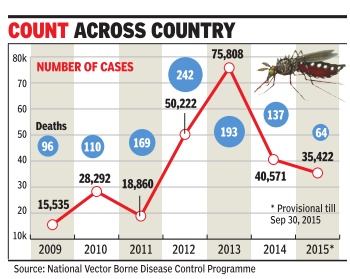
Sushmi Dey
In 2015, Delhi accounted for at least 30 deaths due to dengue, nearly half of the total casualties reported from across the country . Till Octo ber 10, municipal authorities confirmed 10,683 cases, more than the worst dengue outbreak of 1996 with 10,252 cases and 423 deaths. Though hospitals have reported a dip in dengue cases, the incidence of dengue has not ended.
Sources in the ministry said the Centre has sent a “strong message to the Delhi government asking them to act aggressively with swine flu and be prepared with all infrastructure to ensure there is no repeat of a dengue-kind of situation with swine flu“. The ministry will also issue guidelines to the Delhi government on control of swine flu including on vaccination, infection control and standard treatment protocols.
Besides, the Centre is also working to strengthen the overall strategy to deal with tropical and vector borne diseases and create a system wherein states can be made accountable on a regular basis for not doing enough.
“Health is a state subject and states have to take proac tive measures. We can only guide them and help them in their efforts. But we are still trying to develop a mechanism wherein at least we can ask them for a regular update or report on what they are do ng. This is basically in pub ic interest to ensure that we do not wake up suddenly to know states have not done enough,“ a senior official in he health ministry said.
He added there are strict directives from Nadda to de velop a strong mechanism to avoid rise in morbidity as well as death toll.
The health ministry is also holding talks with other ministries such as urban de velopment and HRD to take proactive sanitation measures and rope in school kids as brand ambassadors for spreading awareness about cleanliness. The government also plans to introduce separate chapter in school text books that will deal with vec or-borne diseases and create awareness about symptoms and management of diseases ike dengue, malaria etc.
